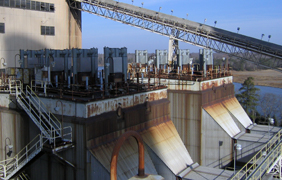Evaluating Electrostatic Precipitator Rapper Performance
The operation of all rapping systems (collecting plates, discharge electrodes and flow distribution devices) is critical to the performance of most ESPs. Failure of a single rapper or of an entire rapping system can occur. This can lead to excessive buildup on the affected precipitator components.
Collecting Plate Buildup
Excessive dust buildup on the collecting plates can lead to severe reductions in precipitator current, increase in precipitator voltage and re-entrainment caused by uncontrolled release of dust from the collecting plates.
Discharge Electrode Buildup
Buildup on discharge electrodes will inhibit corona formation. This will change the charging of particles by either increasing the œelectric diameter of the discharge electrode or wire by accumulation of low resistivity dust or blocking the flow of current altogether by accumulation of high resistivity dust.
Dust, Voltage & Sparkover
Any increase in precipitator voltage by dust buildup on plates or wires will increase the spark rate and dust re-entrainment and thus further reduce the collecting efficiency.
Dust On Gas Distribution Systems
Buildup of dust on gas distribution devices such as perforated plates can lead to partial or almost total blockage. Blockage will cause an increase in pressure drop, or channeling of high velocity gas streams. Blockage and channeling disrupt operation and can severely reduce collecting efficiency.
Rapper Distribution
Individual rappers normally serve a precipitator section smaller than an electrical bus section. Usually, the bus section energized by one transformer/rectifier has several collecting plate and discharge electrode rappers. The failure of one rapper can substantially change the electrical power input into the affected bus section.
Rapper Failures
Electromagnetic rapper system failures can be traced to malfunctions or damage of components, such as:
- Electrical power supplies
- Rapper Controls
- Wiring
- Connecting links and shafts
- Rapper
Pneumatic rapping system failures are most often traced to:
- Compressed air supplies
- Filter, regulation, lubricators
- Selenoid valves
- Connecting links
- Rappers
Total failure of an entire rapping system is easily recognized and typically, easily corrected. Total failure of one or more individual rappers is less obvious and much harder to detect. Once detected, the rapper failure is usually easy to fix.
The partial failure or one or more rappers due to a functional deficiency that decreases the rapping efficacy to near zero is much harder to spot and is also more difficult to remedy.
Helpful Resources
KnowledgeBase: Rapping Systems
KnowledgeBase: Reducing ReEntrainment
KnowledgeBase: Improve Rapping Systems
KnowledgeBase: Equipment Improvements
Our Capabilities: Analytical & Laboratory Services
Our Capabilities: Equipment Assessments & Inspections
Our Capabilities: Precipitator Rapping Systems & Components


